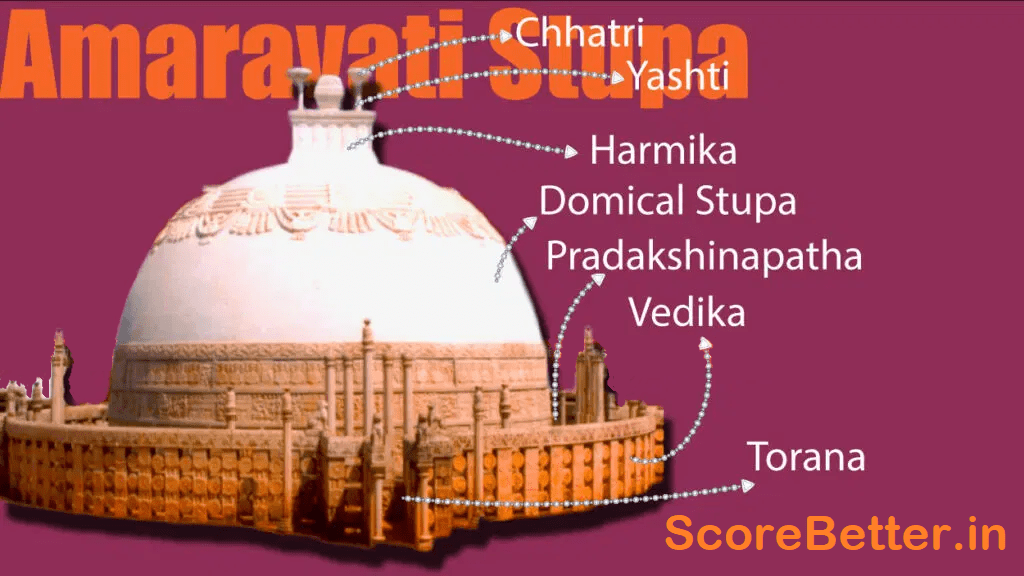Stupas in India: A mound represents what the Sanskrit word for stupa signifies. It began as a straight-forward earthen mound, semicircular in shape, that was eventually given the name Anda. It changed over time and underwent a transformation into a more complicated structure with the inclusion of artwork.
At locations that were regarded as sacred, stupas were erected. These locations were revered because of their connection to Buddha. These mounds, which are referred to as stupas, were used to bury Buddha relics such as his physical remains or tools he used.
Stupa construction may have been a pre-Buddhist custom but eventually became linked to Buddhism.

Important Places of Buddha’s life
Gradually, each of these places came to be regarded as sacred.
- where he was born –Lumbini
- where he attained enlightenment –Bodh Gaya
- where he gave his first sermon –Sarnath
- where he attained Nibbana –Kushinagar.
(The ashes of the Buddha were buried in stupas built at locations associated with important events in the Buddha’s life including Lumbini (where he was born), Bodh Gaya (where he achieved Enlightenment), Deer Park at Sarnath (where he preached his first sermon sharing the Four Noble Truths (also called the dharma or the law), and Kushingara (where he died). The choice of these sites and others was based on both real and legendary events.)
Why were Stupas Built?
Due to their connection to the life of Buddha, certain locations were chosen for the construction of the stupas.
These stupas contained Buddha relics, including his physical remains and the tools he utilized.
Although the practice of building a stupa may have existed prior to Buddhism, it became associated with Buddhism due to the sect’s use of a stupa. Because they held holy relics, the entire stupa became revered as a representation of both Buddhism and the Buddha. The Buddhist text Ashokavadana, mentions that the Great Asoka distributed portions of the Buddha’s relics to every important town and ordered the construction of a stupa over them. By the second century BCE, numerous stupas had been built, including those at Bharhut, Sanchi, and Sarnath.
How were the stupas built?
These stupas’ inscriptions on the pillars and railings attest to the gifts paid for their construction and decoration.
King donors, like the Satavahanas, provided some donations. Guild donors, like the ivory workers who helped fund a portion of one of Sanchi’s gateways, also made some donations.
Hundreds of women and men, whose names were also listed on these inscriptions and occasionally together with the names of their families and the location from whence they originated, contributed donations. These stupas were funded in part by contributions from bhikkhus and bhikkhunis.
The structure of the stupas
- The stupa began as a simple semi-circular mound of earth. And gradually, it evolved into a more complex structure.
- The simple semi-circular mound of earth is called Anda, above this anda is the harmika, a structure resembling a balcony it represents the abode of the gods.
- Rising above from the harmika is a mast called the Yashti, often surmounted by a chhatri or umbrella. Around the mound is a railing known as Vedika.
- The Circumbulatory path between the railing and the Anda is known as Pradakshina.
- The Entrance gate is called Torana.

In order to emulate the sun’s path through the sky, worshippers enter the stupa by the eastern portal and proceed clockwise around the mound, or Anda, following the Pradakshina Path.

Stupas in India
The most prominent Stupas in India are:
| S.No | Stupa Name | Features |
|---|---|---|
| 1 | Papriwaha Stupa | Lumbini, Oldest of all (Built by Ashoka) |
| 2 | Sanchi, Sarnath, and Soneri | These were built during the Mauryan Times, Built by Ashoka the great. |
| 3 | Baruhath Stupa | Sunga Dynasty (built by Ashoka and renewed by Pushyamitra shunga) |
| 4 | Amravati Stupa | Built by the Satavahanas, the Most important of South India. |
| 5 | Nagarjunaconda Stupa | South India, Build by the Ikshvaku dynasty |
| 6 | Mahabodhi Stupa, Bodh Gaya | Build by Asoka |
| 7 | Shanti Stupa, Leh | 1991 by Japanese Buddhist Bhikshu, Gyomyo Nakamura |
| 8 | Dhamekh Stupa, Sarnath | First built in 249 B.C. by Ashoka the Great |
| 9 | Kesaria Stupa, Bihar | The archeologists believe the Stupa in kesaria known to the people as “Raja Ben ka DEORA“ was built by Licchivis of Vaishali before Budha attained Nirvana |
| 10 | Maha Stupa, Thotlakunda | First built in 249 B.C. by Ashoka the Great |
| 11 | Sasaram Stupa | It was built by Raja Harishchandra |
.
Read More Articles on History Art & Culture
Follow on Youtube Channel Score Better
Join Us on Telegram For More Update
.
